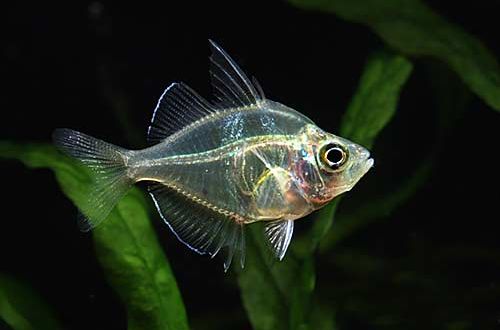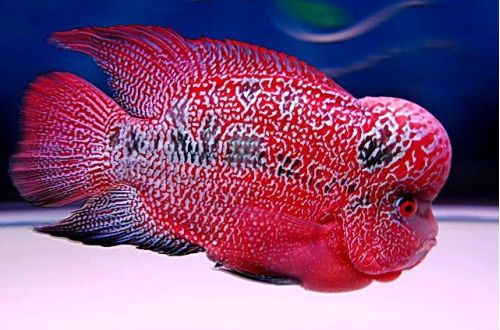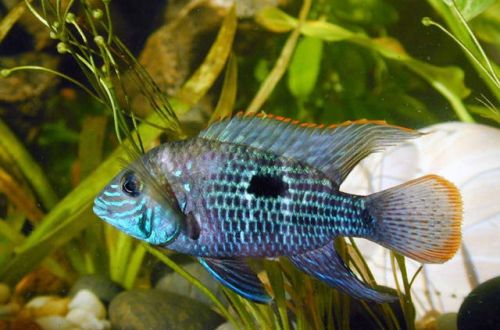
Colombian tetra
The Colombian tetra, scientific name Hyphessobrycon columbianus, belongs to the Characidae family. Easy to keep beautiful peaceful fish. It goes well with representatives of other non-aggressive species. Suitable for small freshwater aquarium

Contents
Habitat
It comes from South America from the basin of the small river Acandí on the border of Colombia and Panama. In the upper reaches of the river pass through the rainforest. In the middle and lower rivers are surrounded by open spaces of vast meadows. The water is muddy, the substrate is sand and gravel. It is worth noting that the word “Acanti” in the dialect of the indigenous population literally means “river of stones.”
Brief information:
- The volume of the aquarium – from 80 liters.
- Temperature – 20-28°C
- Value pH — 5.0–7.5
- Water hardness – soft (1-10 dGH)
- Substrate type – sand and gravel
- Lighting – subdued
- Brackish water – no
- Water movement is weak
- The size of the fish is 5–6.5 cm.
- Meals – any
- Temperament – peaceful
- Keeping in a flock of at least 8-10 individuals
Description
Adult individuals reach a length of about 5-6 cm. The color of males consists of blue (on the back) and silver (on the abdomen) shades. The tail is red. Females are colored less brightly, the predominant color is silver. Fins are translucent.
Food
Accepts all types of dry and live, frozen food. The main condition is herbal supplements. It is desirable to diversify the diet with several types of food. For example, flakes or granules in combination with bloodworms or brine shrimp. You can do without live food if you use high-quality products from well-known manufacturers.
Maintenance and care, arrangement of the aquarium
The optimal size of the aquarium for a small flock of fish starts from 80 liters. Arrangement is arbitrary. Columbian tetra can feel great both among dense thickets of plants and in a half-empty tank. Decor elements and aquatic vegetation are determined by the preferences of the aquarist and / or the requirements of other fish.
The content is simple and does not require much effort. A productive filter, weekly replacement of part of the water (15–20% of the volume) with fresh water and regular cleaning of the soil with a siphon will help to avoid the accumulation of organic waste.
Behavior and Compatibility
Peaceful schooling fish. The content in the group is at least 8–10 individuals. Compatible with other species of similar size and temperament. Aggressive and large fish should be avoided.
Breeding / breeding
The Colombian tetra can breed in a community aquarium. However, the survival rate of fry in this case will not be great. The fry will become a victim not only of other fish, but also of their own parents.
If you plan to start breeding, then you will need a separate tank – a spawning aquarium. The design uses an artificial spawning substrate, or clusters of undersized plants or mosses. A great option is Java moss. The lighting is subdued. The set of equipment consists of a heater, a low power lamp and a simple airlift filter with a sponge. The latter will provide sufficient cleaning, including biological filtration, and is the safest for fry. Use water from the main aquarium.
You can determine the imminent spawning by females. Their belly will noticeably swell from caviar. From this moment, several females and one, the brightest and largest male, are placed in a spawning aquarium. At the end of spawning, they are returned back.
The incubation period lasts about 24-36 hours. In the first days of life, the fry feed on the remains of the yolk, and then switch to microscopic food. An excellent source of food are shoe ciliates, or specialized powdered feed for fry, where food particles do not exceed 50 microns. As you grow older, you can switch to Artemia nauplii.
Fish diseases
Health problems arise only in case of injuries or when kept in unsuitable conditions, which depresses the immune system and, as a result, provokes the occurrence of any disease. In the event of the appearance of the first symptoms, first of all, it is necessary to check the water for the excess of certain indicators or the presence of dangerous concentrations of toxic substances (nitrites, nitrates, ammonium, etc.). If deviations are found, bring all values back to normal and only then proceed with treatment. Read more about symptoms and treatments in the Aquarium Fish Diseases section.





